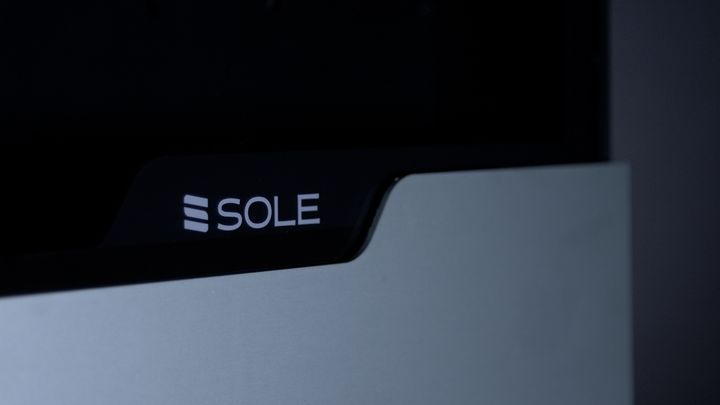
At long last, PodoPrinter has released full details on their now-named device, the SOLE 3D production printer.
PodoPrinter has been a rather mysterious Netherlands-based startup that we’ve been following for a while. They have released only murky images of their device, and provided virtually no details of what it is, for what, or how it works.
But now we know a lot more.
PodoPrinter Mysteries
One of the most curious things about PodoPrinter is that there are a number of Netherlands companies that seem to be related to it through the same individuals. Most seem to be centered around colorFabb, a well-known producer of 3D printer materials.
The first company that’s involved is Blackbelt 3D, which devised a fully functional belt 3D printer. This type of 3D printer prints at an angle onto a moving conveyor belt. This allows production of very long objects, far longer than the device, or a continuous stream of smaller prints for volume production. It’s quite a different concept that I believe will eventually catch on.
PodoPrinter leaked some information early this year hinting that their new device would somehow address the footwear market, but it wasn’t clear what exactly was going on. Then in May a video was uncovered that seemed to suggest the PodoPrinter device somehow used a belt 3D printing system. However, it was unclear to me what was happening, as the murky images of PodoPrinter released at the time did not seem to be the correct form factor for a belt 3D printer.
But now we know why and the answer is startling.
SOLE 3D Printer
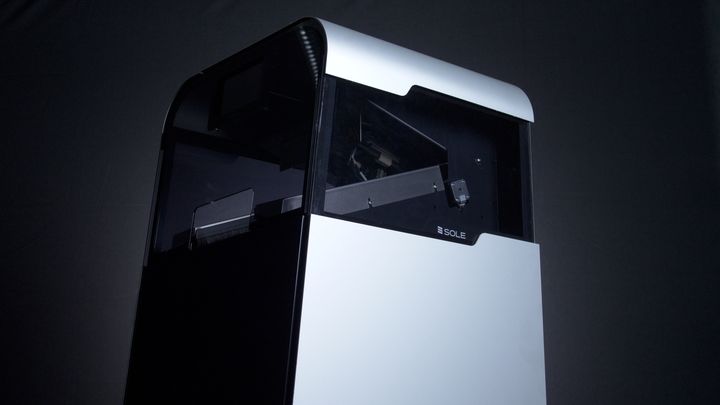
PodoPrinter’s first 3D printer is called the SOLE, and with good reason: it is specifically designed to 3D print insoles for shoes.
And it uses a belt system, as suspected. But it does so in a very different way: the belt is NOT horizontal, like it is in every other belt 3D printer I’ve seen. Instead, the SOLE’s belt is tipped to near-vertical.
This is why I was confused over the leaked images: they did not show a frame capable of holding a horizontal belt system. But the images could definitely hold a vertical belt system.
Could this work? Certainly! 3D printers have long been known to be able to 3D print in different orientations. I’ve seen one device literally 3D print sideways.
This works so long as you have excellent bed adhesion and the 3D print isn’t too big. In the case of the SOLE, they’ve already perfected the belt adhesion with the Blackbelt 3D technology. Also, 3D printed insoles are not exactly the biggest object; they should easily adhere to a belt.
Insoles are also long objects that can easily fit into the SOLE’s very curious build volume: 170mm x 60mm x “infinity”. There is no Z value because the belt can keep turning, effectively making that axis of infinite length. Also note the other dimensions are quite unusual: Objects can only be 170mm wide, which if you think about it, is perhaps the widest possible insole imaginable. Similarly, the tiny 60mm height also defines an “insole envelope”.
This machine is designed 3D print insoles!
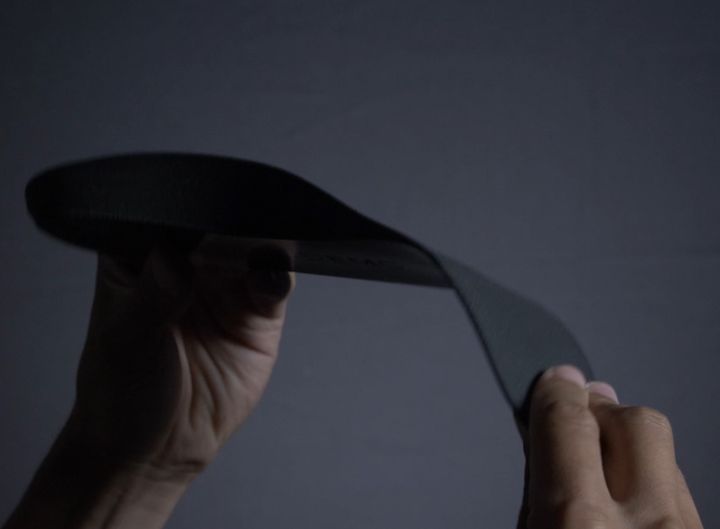
The insoles are produced on the belt and as it turns they peel off the bed and drop down into, presumably, a collection bin. This is evident in an image from a video provided by PodoPrinter:
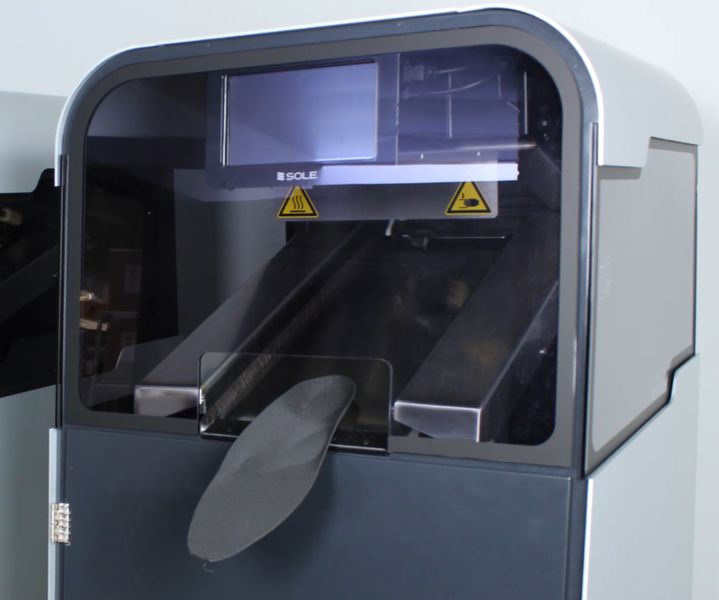
At launch, the SOLE will have two specific materials designed for machine: SOLE Premium 9017 and SOLE Premium 4005. These look to be custom-designed flexible materials suitable for use in insoles, and very likely sourced from their nearby collaborator, colorFabb. Another clue is that the materials formulation is able to produce micro-bubbles during 3D printing that aid in flexibility and shock absorbing characteristics. By mere coincidence, this sounds quite a bit like colorFabb’s VarioShore material.
For software, PodoPrinter provides PodoCAD, or you can use LutraCAD with a PodoCAD plug-in. LutraCAD is software created specifically for the design of insoles.
Another curious specification for the SOLE 3D printer is the “print head”, which is specified as “1.2mm”. I take this to mean the nozzle diameter is 1.2mm, which is quite a bit larger than the typical 0.4mm diameter. The larger nozzle would dramatically increase machine throughput, but at the cost of resolution. However, does resolution really matter for an insole that you’ll never see?
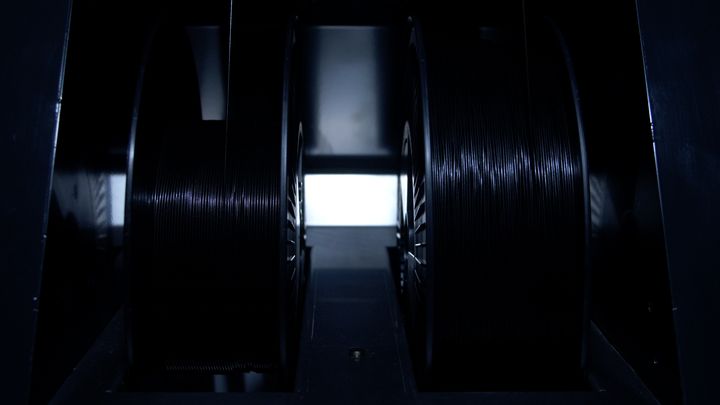
The other major characteristic of the SOLE is that it is designed for 24/7 operation: it’s a true production 3D printer. It meets many of the factors in my definition of a “Production 3D Printer”, including the fact that the SOLE has two input spools; it isn’t said, but it may be possible that it can automatically switch spools when one runs out. They say it can run “8 days unmanned”.
Pricing for the device is set at €25,000 and filament is sold for €300 per spool, but it’s not clear how large the spool will be; it’s probably more much more than 1kg in weight.
PodoPrinter Workflow
One of the most interesting aspects of the SOLE 3D printer is its effects on the target market’s workflows. Today the production of custom insoles is typically a manual business, with individual craftspeople building them with handtools. It’s inefficient, wasteful and dreadfully slow.
The vision of the SOLE 3D printer is to have the device in a professional office, where it could literally print pairs of custom insoles on demand. They say it can produce up to ten pairs per day, which sounds like a little over an hour per insole; that’s pretty fast. Not quite “while you wait”, but getting close.
The way they’ve designed the machine allows for production of insoles with no post-processing. This, along with the software should allow almost anyone to successfully operate the system. A subject’s feet would be scanned, software automatically develops the 3D models, and the SOLE produces them.
PodoPrinter Implications
I find this development quite intriguing, and here’s why.
In theory the Blackbelt 3D printer could 3D print insoles in much the same way. But the folks behind PodoPrinter chose not to go that way. They could have spiffed up the Blackbelt and positioned it as a “footwear 3D printer”, but they did not.
Instead they went back to the drawing board and adapted the Blackbelt concepts and technology into a purpose-built machine, the SOLE, which from every aspect seems to be a machine that will ONLY 3D print insoles. Its build volume, throughput, software and materials are all about insoles.
They’ve chosen to not only target a particular industrial market, but they’ve designed a new machine from ground up specifically to address that market. This is not wholly unprecedented in 3D printing, where most devices are of a more general purpose nature, but is certainly one of very few such systems.
Could this herald a new focus on purpose-built 3D printers for specific industries? If PodoPrinter succeeds, expect there to be an avalanche of such devices.
Maybe PodoPrinter will be making some of them.
Via PodoPrinter
